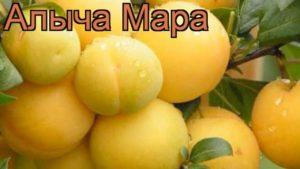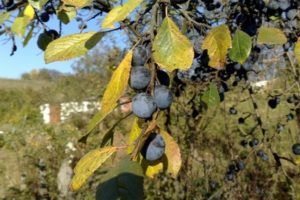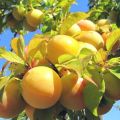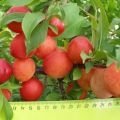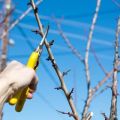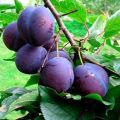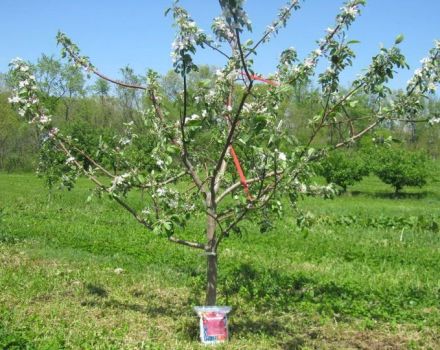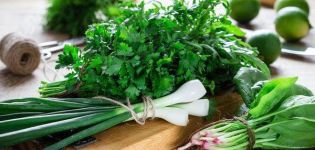Description of the plum variety Volzhskaya beauty, cultivation and care
Plum of the domestic variety Volzhskaya krasavitsa with large tasty fruits is widespread in Central Russia. Plum crops begin to yield from 4 years from the moment they are planted in the garden. The variety is distinguished by early ripening, abundant productivity, good cold resistance. Large fruits with excellent taste characteristics, suitable for various purposes.
Content
- 1 The history of the selection of the Volga beauty
- 2 Description and distinctive features of the plum
- 3 Characteristics of the plum variety Volzhskaya beauty
- 4 The main advantages and disadvantages of plums
- 5 How to plant a plum on the site
- 6 Plum care rules Volzhskaya beauty
- 7 Reviews of experienced gardeners about the plum variety Volzhskaya krasavitsa
The history of the selection of the Volga beauty
In 1939, at an experimental gardening station in the city of Kuibyshev, breeder Evgeny Petrovich Finaev crossed the varieties Renclode Bove and Skorospelki red. So the type of plum was obtained, which was named the Volga beauty. In 1965, the variety was entered into the state register of the Russian Federation. Fruit trees are zoned for the Lower Volga, Middle Volga and Central regions.
Description and distinctive features of the plum
The plum grows quickly, reaching 6-7 m in height. The trunk is straight, the bark is smooth, gray with an ash tint. The branches are powerful, bare. In a small amount there are white lentils. The crown is moderately dense, raised, spherical.
Large oval leaves are flat, dull, medium pubescent, with a rounded base and a sharp tip. The leaf blade has a serrate-crenate edge, attached to a medium, thick petiole with 2 colored glands. Plum fruits develop on bouquets. Flowers of white color are collected in inflorescences of 2-3 pieces.
The fruits of the plum are oval, large, with a prominent seam, weighing about 35 g. Ripe plums with a pronounced waxy coat acquire a solid purple color and a reddish tint. The skin is moderately dense. There is a moderate amount of white subcutaneous spots. The pulp is evenly yellow-orange, juicy, with a pleasant sweet and sour taste (4.5 points). The juice is clear. The stone is oval, medium-sized, pointed on both sides, can be easily separated.
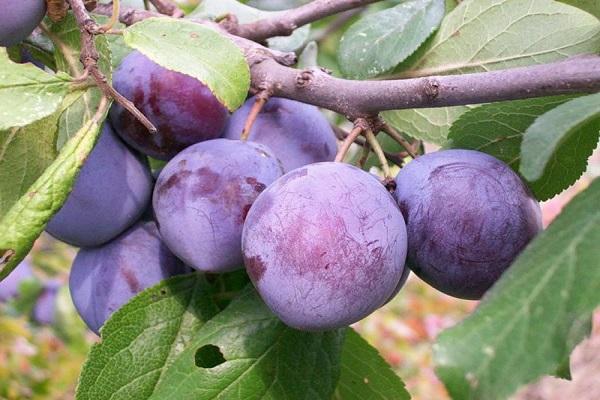
Characteristics of the plum variety Volzhskaya beauty
The reproductive success of the Volga beauty with green cuttings is about 40%. Most often, breeding is carried out by vaccination. Plum prefers light and medium loamy chernozemic moderately moist soils. It grows best on dolomite or calcareous marly soils of clay-carbonate composition.
Plums tolerate light frosts well in sheltered from the wind, well-lit areas.
Many people like large juicy fruits with bright yellow sweet pulp. This variety is very popular with gardeners due to its early maturity, as well as regular abundant fruiting, provided adequate watering and systematic feeding.
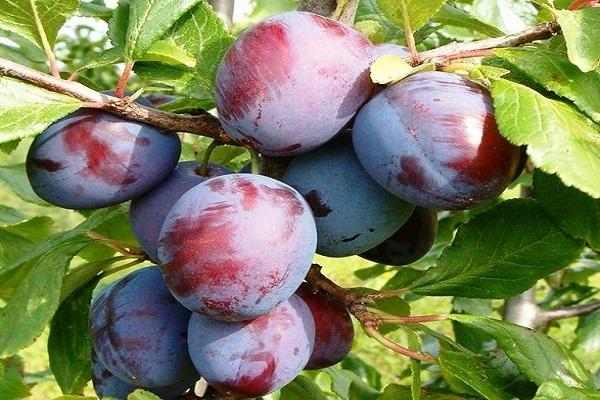
Plum resistance to subzero temperatures and drought
Thanks to the thick bark of the plum, the Volga beauty is able to endure moderate cold without consequences. In terms of winter hardiness, the quality of the variety is average. In severe frosts, vegetative buds can freeze and crumble, reducing the yield of plums. Withstands dry years well.
Exposure to insects and disease
In the plum variety Volzhskaya beauty, gum flow is rarely observed. Also, the plant is resistant to the incidence of gray rot. The risk of injury increases when damaged by a plum moth or cherry elephant. The susceptibility to the moth is low, 0.5-1%.
Plum pollinators
The variety is considered self-fertile, if you plant several plums of similar flowering time next to each other, you can improve the yield. Pollinators suitable for the Volga beauty are Skorospelka red, Zhiguli, Mirnaya, Ternosliv Kuybyshevskaya.

Plum yield and fruiting
Plum saplings from the moment of planting in a permanent place begin to bear fruit for 4-5 years. The yield of 6-8 years old fruit crops is about 8-10 kg, after 9-12 years - 13-25 kg. Flowering begins in mid-May. The taste of the fruit acquires its characteristic sweetness by the beginning of August. Harvest from 10 to 25. Plums have average suitability for transportation. The fruits are recommended to be used before the beginning of September.
Storage and use of fruits
Harvested in dry, sunny weather will prolong the shelf life of fresh plums. After rain, wet fruits become limp, their taste becomes less pronounced. The torn drupes are placed in up to 4 layers in wooden or plastic containers lined with paper.
During the storage period, plums begin to lose their beneficial properties and taste characteristics, so the fruits are recommended to be consumed or processed immediately.
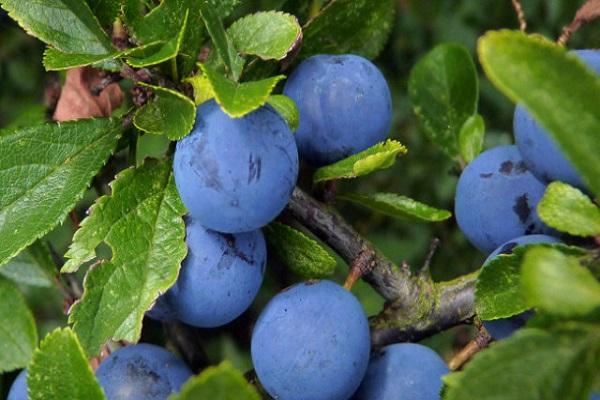
Unripe fruits are left for several days in rooms with a room temperature of 22 - 25 degrees. The shelf life at temperatures up to 6 degrees, without access to direct sunlight and humidity of no more than 90%, is 2 weeks. For long-term storage, plum fruits are frozen, after removing the stone.
The main advantages and disadvantages of plums
The main positive qualities of the Volga beauty plum are abundant regular fruiting, early flowering and ripening periods, large sizes and excellent taste characteristics, and the possibility of transportation.
Among the negative features, they note the large dimensions of the trees, the threat of freezing of flower buds from late frosts, the likelihood of cracking of the peel in a season with high rainfall.
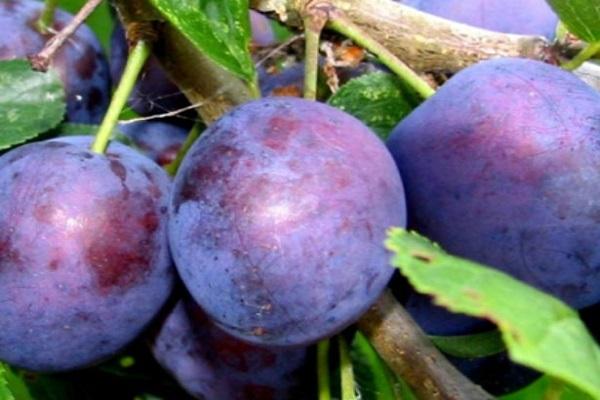
How to plant a plum on the site
There are many factors to consider when planting a healthy, well-developed plum. Particular attention is paid to the choice of seedlings, suitable pollinators, compatible neighbors, and planting sites are selected.
Determining the terms
The Volzhskaya beauty plum is allowed to be planted in the autumn period (end of September) or from mid-April to early May. Spring planting is recognized as more rational.The seedling is placed in the warmed-up ground, allowing it to quickly adapt to a new place, develop the root and aerial parts before the onset of winter cold weather.
Choosing the best place to plant plums
The Volzhskaya krasavitsa variety is preferably planted on flat terrain or areas with a slight slope. Plum loves a lot of sun, grows better and produces more fruits in well-lit, sheltered places. The soil must be breathable, for example light to medium loam. It is not recommended to plant plums in lowlands with a high degree of soil moisture, as well as in areas with a close location of groundwater.
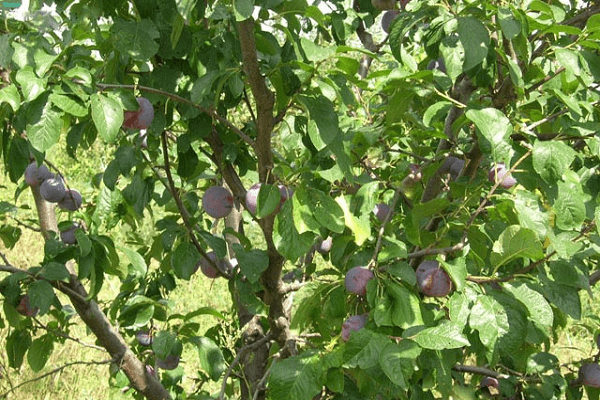
Plum Compatible and Incompatible Neighbors
Plums can be planted next to an apple tree. Joint cultivation with cherries, cherries, peaches, walnuts, pears is undesirable. The Volga beauty quietly coexists with bushes of raspberries, currants, gooseberries, honeysuckle and barberry.
Seedling preparation
It is advisable to purchase 2-year-old trees 1-1.5 m high. When choosing, pay attention to the roots and the appearance of the plant. The root system should be well developed, slightly moist, from 20 cm long. Healthy seedlings have a smooth bark, without damage and dry shoots. Before planting, remove leaves, broken branches, dried roots.
Planting technological process
Having decided on the place, they dig a hole 0.5 m deep and 1 m wide. The soil is mixed with organic or complex mineral fertilizers. The resulting mixture is poured into a pit with a mound, and a wooden peg is placed there.

The seedling is placed on a prepared earthen elevation from the north side in relation to the peg, straightened and evenly spaced the roots, sprinkled with earth. In this case, the tree is periodically shaken, the soil is trampled down a little so that there are no voids.
The root collar should be 5 cm above ground level. After planting, the seedling is tied to a support.
Having retreated from the trunk by half a meter, a recess is dug around the perimeter for watering. 1 plum requires 3 buckets of water. After that, the near-trunk area is mulched with sawdust or rotted manure.
Plum care rules Volzhskaya beauty
Like any fruit tree, the plum requires systematic care. To get a good tasty harvest, it is necessary to ensure proper watering, top dressing, pruning, as well as timely treatment against pests and diseases. Due attention is paid to the formation of the crown and the care of the trunk circle.
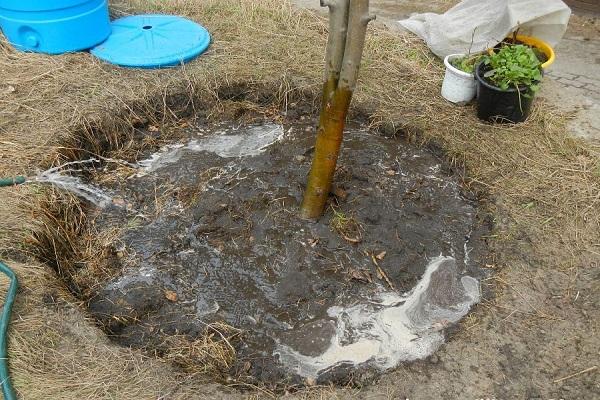
Watering and feeding
When organizing watering, it is important to maintain balance. Drought causes the ovaries to fall off, and excessive moisture can lead to cracking of the fruit. Additional moisture will not interfere with flowering, formation and ripening of plums, after removing the fruits and before the onset of cold weather.
Fertilizers can be applied throughout the season, observing the recommended amount of substances. In spring and autumn, top dressing is aimed at feeding the roots; in the summer, the aboveground part is treated. In the spring, 3 dressings are carried out:
- before flowering: 30 g / m22 ammonium nitrate solution;
- during flowering: 10 g urea / 5 l water;
- after flowering: insist 1 kg of chicken droppings in 12 liters of water (consumption of 2 liters per 1 plum).
In the summer, potash and phosphorus supplements are used. In the fall, trees are fertilized to prepare them for winter. Most often used chloride or sulphide potassium, superphosphate.

Crown formation
In the first year of growth, the plum sapling does not need to be cut. From the 2nd year in the spring, when the buds awaken, they begin to form a crown in a sparse-tiered or non-tiered type, avoiding strong thickening or excessive thinning. The central conductor should take the leading position, it is cut by 2/3.The main branches are left 20 cm long, the lateral shoots are shortened to 15 cm above the bud directed downward.
Pruning is repeated in summer, removing growths up to 20 cm. Strong branches are bent and fixed with twine. For the Volzhskaya plum, the sparse-tiered type with the formation of three tiers is preferable:
- for the first, 3 branches are used at a height of about 70 cm from the soil surface;
- the second is made of 2 branches 70 cm from the first;
- the third tier of 1 branch is placed at a distance of 50 cm from the second.
Further care of the plum consists in annual thinning, removal of competitive, dry, damaged branches.

Diseases and pests, methods of control and prevention
A strong well-groomed plum tree of the Volga beauty is resistant to major diseases, it is enough to periodically carry out preventive measures to protect it. When signs of damage appear, there is a need for emergency measures.
From clasterosporium disease, moniliosis, the development of fungi, the following remedies are used:
- in the spring of 2 treatments with "Fitosporin" according to the instructions;
- at the end of flowering, during the growing season, 2 treatments with "Horus" or "Fast";
- for prophylaxis 5% urea solution, 3% Bordeaux liquid, "Actellic".
From aphids use "Bitoxibacillin", "Skor", "Planriz", "Zircon", "Aktofit". To prevent the breeding of the cherry elephant in the spring, they dig up the soil under the tree.
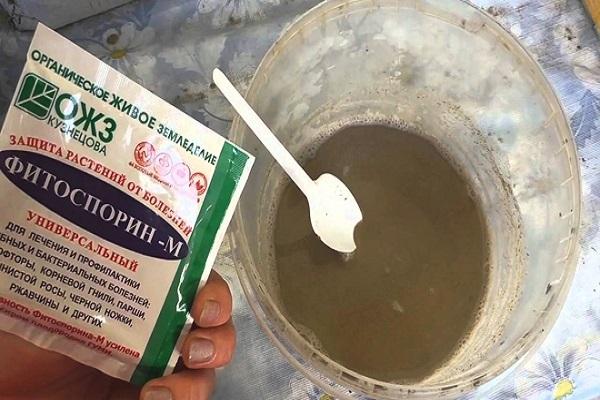
Barrel circle care
During the first year after planting, it is important to gently loosen and remove weeds from the top layer of soil around the trunk of the plum. This will provide the young tree with maximum nutrition and oxygen saturation, will contribute to rapid rooting and normal development.
Plum protection from rodents
Hares and voles can damage plum trees, so you should reliably cover the trunks or use special deterrents. To protect the bark, the trees are wrapped with spunbond, roofing felt, fiberglass or suitable materials at hand. You can furnish branches of spruce branches around the plum, install a metal mesh.
Shelter for the winter
A young seedling does not require feeding. For the winter, it must be covered with branches, a layer of hay, and tied with a rope. You can also wrap a sapling with several layers of paper. In adult plants, the trunk circle is covered, the trunks and large branches are whitened.
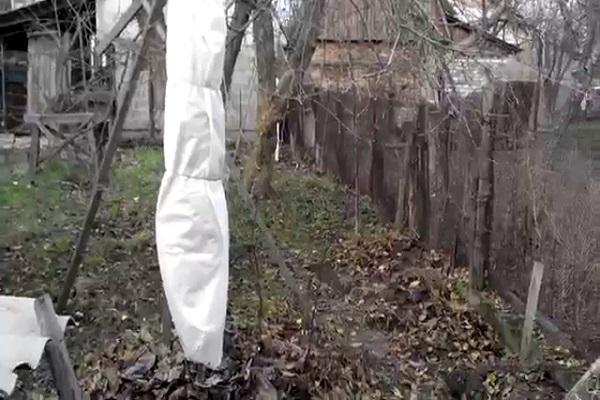
Reviews of experienced gardeners about the plum variety Volzhskaya krasavitsa
Oleg, 45 years old
12 years growing in the garden plum variety Volzhskaya. The tree has grown large, I harvest every year, the fruits are large, very tasty. The main thing is to timely and properly care for the tree.
Lyudmila, 37 years old
I really like this variety. Grows on the site without pollinators. Plums are very juicy, tasty, almost all of them are eaten fresh. It is good to stick to the branches, they do not fall off for a long time when they ripen. It is difficult to get to all the branches, the tree has grown very large.
